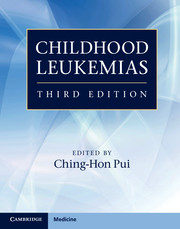Book contents
- Frontmatter
- Contents
- List of contributors
- Preface
- Section 1 History and general issues
- Section 2 Cell biology and pathobiology
- Section 3 Evaluation and treatment
- 12 Pharmacokinetic, pharmacodynamic, and pharmacogenetic considerations
- 13 Acute lymphoblastic leukemia
- 14 Relapsed acute lymphoblastic leukemia
- 15 B-cell acute lymphoblastic leukemia and Burkitt lymphoma
- 16 Acute myeloid leukemia
- 17 Relapsed acute myeloid leukemia
- 18 Myelodysplastic syndrome
- 19 Chronic myeloproliferative disorders
- 20 Leukemias in patients with Down syndrome
- 21 Treatment of adolescents and young adults with acute lymphoblastic leukemia
- 22 Hematopoietic stem cell and natural killer cell transplantation
- 23 Treatment of acute leukemia in countries with limited resources
- 24 Antibody-targeted therapy
- 25 Adoptive cellular immunotherapy
- 26 Gene transfer: methods and applications
- 27 Development therapeutics
- 28 Minimal residual disease
- Section 4 Complications and supportive care
- Index
- Plate Section
- References
24 - Antibody-targeted therapy
from Section 3 - Evaluation and treatment
Published online by Cambridge University Press: 05 April 2013
- Frontmatter
- Contents
- List of contributors
- Preface
- Section 1 History and general issues
- Section 2 Cell biology and pathobiology
- Section 3 Evaluation and treatment
- 12 Pharmacokinetic, pharmacodynamic, and pharmacogenetic considerations
- 13 Acute lymphoblastic leukemia
- 14 Relapsed acute lymphoblastic leukemia
- 15 B-cell acute lymphoblastic leukemia and Burkitt lymphoma
- 16 Acute myeloid leukemia
- 17 Relapsed acute myeloid leukemia
- 18 Myelodysplastic syndrome
- 19 Chronic myeloproliferative disorders
- 20 Leukemias in patients with Down syndrome
- 21 Treatment of adolescents and young adults with acute lymphoblastic leukemia
- 22 Hematopoietic stem cell and natural killer cell transplantation
- 23 Treatment of acute leukemia in countries with limited resources
- 24 Antibody-targeted therapy
- 25 Adoptive cellular immunotherapy
- 26 Gene transfer: methods and applications
- 27 Development therapeutics
- 28 Minimal residual disease
- Section 4 Complications and supportive care
- Index
- Plate Section
- References
Summary
Introduction
Since Köhler and Milstein first demonstrated that monoclonal antibodies (MoAb) directed against human differentiation antigens could be generated from hybridomas, which made large-scale production of MoAbs possible, there has been the expectation that these reagents would be used to treat hematologic malignancies. Subsequently, it was reported that fragments of antibody variable domains (Fv) could be linked together to make recombinant proteins capable of antigen binding. Methodologies in antibody engineering have since been developed to produce MoAbs and their fragments for clinical use and to generate constructs and conjugates with improved stability, more favorable pharmacokinetic profiles, increased affinity, enhanced effector functions, and reduced immunogenicity. This has facilitated the development of a large and growing number of MoAb-based agents that target antigens expressed by lymphohematopoietic cells for study and treatment in humans (Table 24.1). Leukemias are in general excellent candidates for MoAb-based targeted therapies because some antigens expressed on the surface of malignant cells are relatively lineage restricted and have limited normal tissue distribution (reviewed in Ch. 4). Since the late 1990s, significant progress has been made in the clinical application of antibody-targeted therapies in specific subtypes of leukemias and lymphomas in adults, leading to US Food and Drug Administration (FDA) approval for some of these novel drugs (Table 24.1). Many of the available MoAb-based agents that target lymphohematopoietic cell surface antigens have relevance to childhood leukemias, although at the time of writing this edition, only a small number of pediatric clinical trials have been conducted (reviewed in detail below). These studies offer proof of principle that MoAb-based therapeutics have the potential to overcome leukemia cell resistance to standard therapies and have relatively low risk of non-specific toxicities.
- Type
- Chapter
- Information
- Childhood Leukemias , pp. 563 - 581Publisher: Cambridge University PressPrint publication year: 2012



